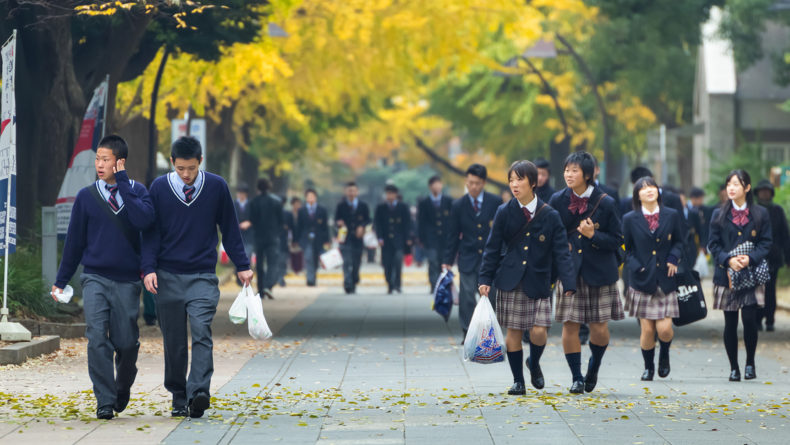
January 2, 2025
Japanese High School Boys Are Waiting for Their First Kiss
Youth intimacy declines in Japan as self-pleasure rises
First crushes, confusing young romance or maybe an awkward (and way too wet) first kiss—that’s what many teenagers traditionally associate with high school. But in Japan, these experiences are shifting, as intimacy and relationships are falling out of fashion among today’s youth.
According to a new survey from the Japan Association for Sex Education (JASE), today’s teens are rewriting the rulebook on intimacy. A record-low number of high school boys have experienced their first kiss—only about one-fifth—marking the lowest rate recorded in the national survey since 1974. The age for first sexual encounters also continues to dip and more students than ever are skipping relationships altogether. The survey suggests that physical closeness is being swapped for self-reliance—and this isn’t just a quirky Gen Z shift; it’s a shift that could play a determining role in Japan’s future.
Intimacy on Hold
The familiar “firsts” that once marked the teenage years are no longer urgent milestones for today’s Japanese youth. While some point to stricter parenting or the lure of a digital world for reasoning, something more profound seems to be at play. Tamaki Kawasaki, a sociology lecturer at Rikkyo University, suggests that today’s teens aren’t avoiding relationships—they’re simply rethinking the role relationships should play in their lives.
Personal independence, career ambitions and self-sufficiency are central to young people’s identities. Economic uncertainty and increasing mental health challenges among teens are adding to this shift, pressuring them to focus on future goals over future relationships. Where physical closeness was once a given, it’s now just one path among many. And this isn’t a fleeting trend. It marks a long-term shift in how the next generation views connections and relationships.
A Private World
The survey reveals a significant rise in solitary behaviors, particularly when it comes to masturbation. Across all age groups in high school, teens are turning more to self-satisfaction—a trend that may go hand-in-hand with their increasing detachment from physical intimacy. The number of high school boys who say they’ve had sexual intercourse dropped by 3.5 percentage points, now sitting at 12%. For high school girls, the rate dropped by 5.3 percentage points to 14.8%.
For today’s youth, the idea of intimacy doesn’t always require a partner. The ease and privacy of digital spaces make it simpler to manage their desires without the complexities of physical relationships. Of course, this increase in self-satisfaction may reflect more than just changing intimacy norms; it’s also a common part of adolescent sexuality—a phase where teens mature and start to explore different facets of their emerging sexual identities.
Kawasaki attributes this shift to the Japanese sex education system, which she describes as ‘prevention-based,’ focusing on risks like sexually transmitted infections and unwanted pregnancies. This emphasis on the negative aspects of sexuality, without promoting a positive view of intimacy, leads to a fear-based understanding of relationships and sex. Kawasaki argues that this discourages exploration and fails to nurture a healthy mindset about sexuality, potentially creating an environment where intimacy is approached with caution rather than curiosity.
Learning From What You See
Family life, too, plays a significant role in shaping how young people view intimacy. With nearly half of Japanese marriages now classified as “sexless,” according to the Japan Family Planning Association, high school students may be taking cues from what they observe at home. In many households, relationships are less about romance and more about practical companionship, where physical intimacy takes a backseat.
Watching their parents engage in functional but emotionally distant relationships, teens may start to view intimacy as less necessary or even irrelevant. In this quiet shift, the message is clear: romance isn’t essential to building a fulfilling life. This outlook is for some on its way to becoming the norm, and it’s leading to a generation that sees physical intimacy as an optional component of adulthood, rather than a foundational one.
This reserved approach to relationships doesn’t just affect households—it actively shapes broader cultural norms, keeping public displays of affection rare. Japan’s culture prioritizes personal space and privacy, so young people have fewer opportunities to naturally learn about intimacy and physical touch. Kawasaki argues that this lack of physical engagement leads to misunderstandings about how to relate to others romantically, further contributing to the growing trend of sexual disengagement among teens.
Beyond High School
What happens when today’s teens, raised in an environment where relationships and intimacy are increasing, become tomorrow’s adults? Researchers like Kawasaki believe the implications stretch far beyond high school, directly impacting Japan’s ongoing demographic crisis.
With one of the world’s lowest birth rates, Japan is already facing the urgent challenge of its shrinking population. The decline in intimacy among young people could only exacerbate the issue, increasing pressure on the government to address the population decline. Japan’s fertility rate has been falling for decades, hitting a record low in 2023.
While factors like rising living costs and more women focusing on careers have led to fewer people having children, the shift in young people’s attitudes toward relationships and intimacy worsens these issues. As teens prioritize solitude over relationships, Japan’s demographic challenges may deepen
The survey doesn’t just highlight delays in teenage romance and the absence of their first kiss—it offers a glimpse into the future of Japan’s social fabric.
———
You might also be interested in reading Life as a Kabukicho Bunny Girl.







